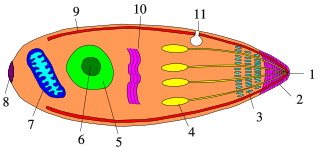Related Research Articles

The Apicomplexa are a large phylum of parasitic alveolates. Most of them possess a unique form of organelle that comprises a type of plastid called an apicoplast, and an apical complex structure. The organelle is an adaptation that the apicomplexan applies in penetration of a host cell.

Plasmodium is a genus of unicellular eukaryotes that are obligate parasites of vertebrates and insects. The life cycles of Plasmodium species involve development in a blood-feeding insect host which then injects parasites into a vertebrate host during a blood meal. Parasites grow within a vertebrate body tissue before entering the bloodstream to infect red blood cells. The ensuing destruction of host red blood cells can result in disease, called malaria. During this infection, some parasites are picked up by a blood-feeding insect, continuing the life cycle.

Coccidia (Coccidiasina) are a subclass of microscopic, spore-forming, single-celled obligate intracellular parasites belonging to the apicomplexan class Conoidasida. As obligate intracellular parasites, they must live and reproduce within an animal cell. Coccidian parasites infect the intestinal tracts of animals, and are the largest group of apicomplexan protozoa.

A gametocyte is a eukaryotic germ cell that divides by mitosis into other gametocytes or by meiosis into gametids during gametogenesis. Male gametocytes are called spermatocytes, and female gametocytes are called oocytes.

Plasmodium vivax is a protozoal parasite and a human pathogen. This parasite is the most frequent and widely distributed cause of recurring malaria. Although it is less virulent than Plasmodium falciparum, the deadliest of the five human malaria parasites, P. vivax malaria infections can lead to severe disease and death, often due to splenomegaly. P. vivax is carried by the female Anopheles mosquito; the males do not bite.
Eimeria tenella is a species of Eimeria that causes hemorrhagic cecal coccidiosis in young poultry. It is found worldwide.
Eimeria stiedae is a species of Eimeria that causes hepatic coccidiosis in rabbits. It was observed for the first time by Antonie van Leeuwenhoek in 1674.

Leucocytozoon is a genus of parasitic alveolates belonging to the phylum Apicomplexa.

Conoidasida is a class of parasitic alveolates in the phylum Apicomplexa. The class was defined in 1988 by Levine and contains two subclasses – the coccidia and the gregarines. All members of this class have a complete, hollow, truncated conoid. Gregarines tend to parasitize invertebrates with the mature gamonts being extracellular, the coccidia mostly infect vertebrates and have intracellular gamonts.
Karyolysus is a genus of coccidia. With the exception of K. sonomae whose vertebrate host is the yellow-legged frog, species in this genus only infect lizards of the genus Lacerta.

Apicomplexans, a group of intracellular parasites, have life cycle stages evolved to allow them to survive the wide variety of environments they are exposed to during their complex life cycle. Each stage in the life cycle of an apicomplexan organism is typified by a cellular variety with a distinct morphology and biochemistry.
Dactylosoma is a genus of parasitic alveolates of the phylum Apicomplexia.
Leucocytozoon caulleryi is a species of the genus Leucocytozoon, a genus of parasitic alveolates.
Atoxoplasma is a genus of parasitic alveolates in the phylum Apicomplexa. The species in this genus infect birds. They are spread by the orofaecal route.
The Archigregarinorida are an order of parasitic alveolates in the phylum Apicomplexa. Species in this order infect marine invertebrates — usually annelids, ascidians, hemichordates and sipunculids.
Cytauxzoon is a genus of parasitic alveolates in the phylum Apicomplexa. The name is derived from the Greek meaning an increase in the number of cells in an animal.
The Ophryocystidae are a family of parasites in the phylum Apicomplexa. Species in this family infect insects.
Merogregarina is a genus of parasitic alveolate in the phylum Apicomplexa. Species in this genus infect marine invertebrates.
Plasmodium coatneyi is a parasitic species that is an agent of malaria in nonhuman primates. P. coatneyi occurs in Southeast Asia. The natural host of this species is the rhesus macaque and crab-eating macaque, but there has been no evidence that zoonosis of P. coatneyi can occur through its vector, the female Anopheles mosquito.

Cystoisospora belli, previously known as Isospora belli, is a parasite that causes an intestinal disease known as cystoisosporiasis. This protozoan parasite is opportunistic in immune suppressed human hosts. It primarily exists in the epithelial cells of the small intestine, and develops in the cell cytoplasm. The distribution of this coccidian parasite is cosmopolitan, but is mainly found in tropical and subtropical areas of the world such as the Caribbean, Central and S. America, India, Africa, and S.E. Asia. In the U.S., it is usually associated with HIV infection and institutional living.
References
- 1 2 3 4 Huff, Clay G. (1942). Schizogony and gametocyte development in Leucocytozoon simondi and comparisons with Plasmodium and Haemoproteus in studying parasitic diseases. The Journal of Infectious Diseases. Volume 71. Oxford University Press.
- 1 2 3 Apicomplexia lifecycle. Accessed 4/13/2012.
- ↑ Impact Malaria Training website. Accessed 4/13/12.
- 1 2 3 4 Lainson, Ralph and Naiff, Roberto D. Haemoproteus (Apicomplexa: Haemoproteidae) of tortoises and turtles. (1998). The Royal Society. London.
- 1 2 Hill, A.G. and Howe, L. and Gartrell, B.D. and Alley, M.R. (2010). Prevalence of Leucocytozoon spp, in the endangered yellow-eyed penguin Megadyptes antipodes. Parasitology. Cambridge University Press. London.
- 1 2 Brunnert, Steven R., Citino, Scott B., Herron, Alan T., and Altman, Norman H. (1992). Hepatic coccidiosis in chamois (Rupicapra rupicapra). Journal of Zoo and Wildlife Medicine. Volume 23. pp 276-280.
- ↑ Stidworthy, Mark F. and Greenwood, Andrew G. (2006). Deaths in aviary birds associated with protozoal megaloschizonts. Veterinary Record. Volume 159. Issue 18. UK.
- ↑ Atkinson, Carter T. and Forrester, Donald J. (1987). Myopathy associated with megaolschizonts of Haemoproteus meleagridis in a wild turkey from Florida. Journal of Wildlife Diseases. Volume 23. Issue 3. pp 495-499.